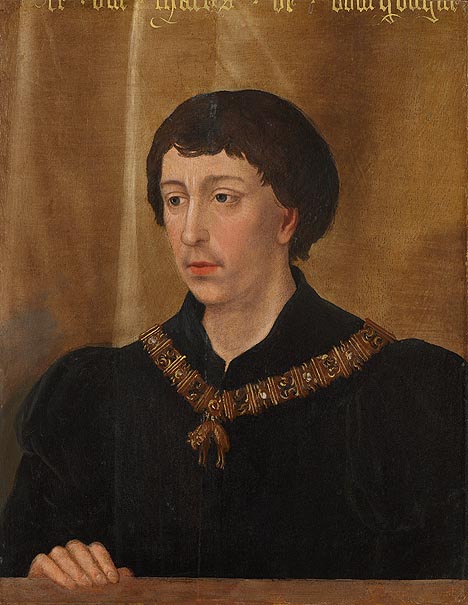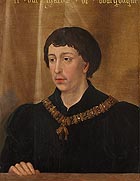
translated and summarized by: Liz Wollner-Grandville,
English summary November 16 - 22
Kunsthistorisches Museum: Charles the Bold – Splendour and fall of the last Duke of Burgundy
Autumn
Charles the Bold, known by his enemies as Charles the Terrible, was bold beyond the range of tolerance. He involved himself in a series of wars and battles with France and Switzerland, which ultimately led to his downfall and death. Not even his marriage policy could save him. In 1477, he perished in the Battle of Nancy. What remains of him is the orthodoxy of the court ceremonial and his Knighthood of the Golden Fleece, the reign over Flanders and its extremely wealthy cities, numerous precious objects, and Austria’s disposal over these treasures.
The exhibition at the Kunsthistorisches Museum (KHM) is the first exhibit organized entirely by the new director. But the decision to do so was not really bold. The KHM’s divisions are in line: contributions were made the KHM's painting collection, the armoury, and the art chamber even offered its rooms.
But there are two things one would have desperately needed, which are not on display. The only fairly good authentic portrait of the audacious debutant, created in Rogier’s workshop, domiciled today in Berlin, is missing. Instead the exhibit is plastered with copies of this painting; and there is even a baroque-like new interpretation of Rubens from the museum’s own collection. And what else is missing is the most important example of book painting, Maria of Burgundy’s hour book; to be found in the Austrian National Library. It is surprising that this book is not displayed, because the practice to show a copy instead of the original throughout the entire exhibition is unchallenged.
The most important book on the topic is titled “Autumn of the Middle Ages”. The author Johan Huizinga emphasizes that the Old Dutch 15th century was not a new beginning, but rather the late years, the triumphant but definitive end of an era. It is therefore unavoidable to remark that the exhibition of the KHM under the new directorship is not exactly what one would consider a start. It is, precisely, autumn.
By Rainer Metzger
Kunsthistorisches Museum
1010 Vienna, Burgring 5, until 10.01.10
www.khm.at
MUMOK Museum of modern Art: Interstices – La Coleccion Jumex, Mexico
Platitudes and Interstices
Exhibitions of large contemporary art collections are always also part of a visual construction of meaning. They mediate values and thereby encroach in contentions over social hegemony. In 1990, the Argentine-Mexican culture critic Néstor Garcia Canclini represented this thesis in his book “Culturas Hibridas” (hybrid cultures). In this investigation of the specifics of cultural Modernism in Mexico, Garcia Canclini devotes himself to the effective as well as failed attempts of artists to escape from Modernism, its colonial heritage and its increasing capitalisation.
The catalogue of this exhibition, in which works of the collection of the Mexican fruit juice-producer JUMEX are presented at the Vienna MUMOK, you will find an interview with the important theoretician, who is hardly known in the German-speaking world. Cultural interstices are not only interpreted as places of communication, but also as those of potential resistance.
Where there is an in-between the dichotomous poles must indeed be relatively intact. But the exhibition seems to deal more with the softening of contrasts and the merging of the core with the periphery, of up and down, and as it says in the exhibition text “the fading of left and right ideologies”. That the latter is an ideology in itself, by which art orchestrated the marching-through of neoliberalism, is presented by Francis Alys’s metaphor: in his video installation, a Mexican band is playing patriotic songs, while “musical chairs” is shown on another screen. Some don’t make it. Good seats need good starting points as well as quick reactions. Marcela Astorga’s sculpture “Masochist Grill”, on a pedestal made of braided leather military belts, reminds of the violent and far-reaching economic and social model of the military dictatorship of the 1970’s and 80’s.
While the individual works of the, not only Latin American, artists are absolutely convincing, the attributions to the rather generalized categories such as “identity and society” or “politics and economy” are far too constrained. The JUMEX-collection is more of a conglomeration of diverse commentaries on today’s massive problems concerning migration and globalization. In any case, the commitment to hegemonic battles in the spirit of Garcia Canclini is not very adventurous or daring.
By Jens Kastner
MUMOK Museum moderner Kunst
1070 Vienna, MuseumsQuartier, until 07.03.10
www.mumok.at
PalaisProject: Robert Majkut, Will Alsop
Border violation
Originally, Lukas Feichtner’s Palais Project in the Palais Breuner in Vienna’s Singerstrasse focussed on Asian art. But these days co-financing through art collectors has become increasingly difficult and the gallery owner decided to go for a more open concept.
Until December 15, the gallery presents itself as the design palais Vienna and centres on the creative process in general, devoted the boundaries between art, architecture and design.
The renowned British architect Will Alsop visualized his perceptions of the creative design process with a huge installation. For the planning of two new college campuses in Glasgow he not only offered the users of the building the opportunity to verbalize their perceptions and ideas in interviews, he also enabled them to visualize these ideas in a draft sketch. Elements of the interviews as well as the sketches were later integrated into the planning process - all documented and presented on small screens. A beautiful example for the interaction among planers and users, and an introduction into the architect’s world of thought, who, by the way, this summer announced that he, from no on, was planning to devote himself to painting. But since the beginning of November he went back to his architectural world and is now cooperating with the British architects RMJM, with offices in Europe, Asia and the USA.
In the second part of the exhibition, the Polish designer Robert Majkut, who is well known in Poland for his spectacular shop designs, questions the process of object design. However, to a large extent his aim to open the boundaries between art and design remains unfulfilled. The large-scale graphic, representing the starting point for a table design is too strongly linked with its digital origins, and the application of the graphic to a specially designed table does not transgress the border between object design and art, something which is obviously easier to overcome through an artist’s approach.
By Werner Rodlauer
PalaisProject
1010 Vienna, Singerstrasse 16, until 15.12.09
www.palaisproject.com
artlounge Strabag Kunstforum: Jan Serych – Paramnesia
Existential and intellectual
The first thing that catches ones eye at this exhibition is definitely the most important artwork displayed: black canvases with text fragments and a white dot in the middle, freely positioned in a row. The second thing that strikes ones’ attention is that these are completely enigmatic fragments of quotes and formulas. Step by step, while proceeding through the exhibition, the game of associations develops from one picture to the next. It all starts with the value of “Pi”, which is so important in physics, to arrive at the single white dot on the black plane, the indivisible – via the absolute zero of 0 K on the Kelvin scale (minus 273,15 degrees Centigrade). In addition to these physical and philosophical allusions, there is one reference to an art context, to Nam June Paik. But these associations have less in common with the conventional definition of fine arts as such, but are more of an intellectual game, a pleasure for viewers knowledgeable of philosophy, and at least semi-educated in the field of physics. But the aesthetic and visual pleasures, the charm of seeing, remain unfulfilled. With this work, seeing equals understanding, not viewing, as there is not much to be viewed.
In contrast, the black and white canvases titled Part 1, Part 2, and Part 3 offer a feeling that is close to pure aesthetic pleasure. Here, the effective composition stands out.
This is by all means a charming, but rather reserved show by an artist, who deliberately reaches out to an extremely intellectual audience.
By Wolfgang Pichler
artlounge Strabag Kunstforum
1220 Vienna, Donau-City-Strasse 9, until 04.12.09
www.strabag-kunstforum.at
Mehr Texte von translated and summarized by: Liz Wollner-Grandville


 Teilen
Teilen





